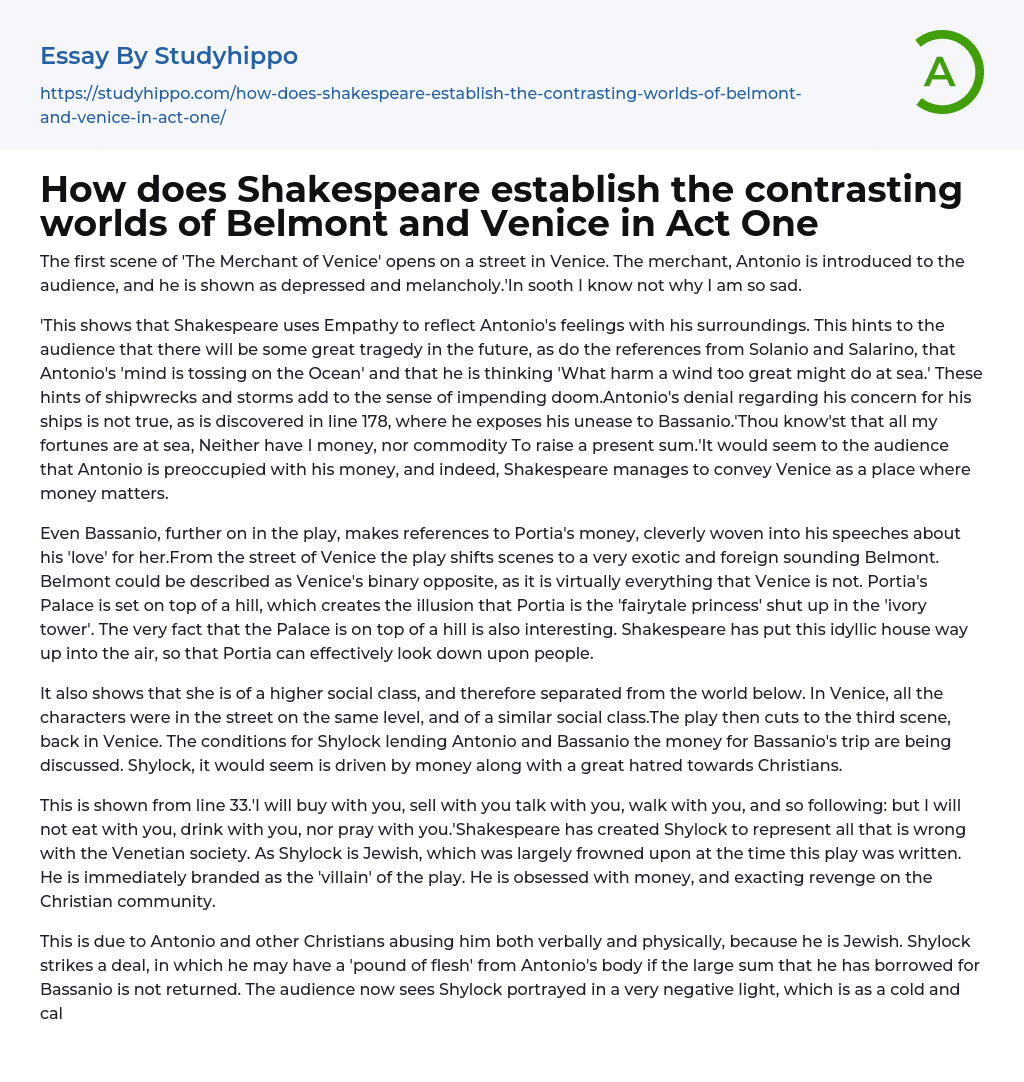

ombre themes in the play.Empathy and Sombreness in The Merchant of Venice
The first scene of 'The Merchant of Venice' opens on a street in Venice. The merchant, Antonio is introduced to the audience, and he is shown as depressed and melancholy.'In sooth I know not why I am so sad.
'This shows that Shakespeare uses Empathy to reflect Antonio's feelings with his surroundings. This hints to the audience that there will be some great tragedy in the future, as do the references from Solanio and Salarino, that Antonio's 'mind is tossing on the Ocean' and that he is thinking 'What harm a wind too great might do at sea.' These hints of shipwrecks and storms add to the sense of impending doom.Antonio's denial regarding his concern for his ships is not true, as is discovered in line 178, where he exposes his unease to Bassanio.'Thou know'st that all my fortunes
...are at sea, Neither have I money, nor commodity To raise a present sum.'It would seem to the audience that Antonio is preoccupied with his money, and indeed, Shakespeare manages to convey Venice as a place where money matters.
Even Bassanio, further on in the play, makes references to Portia's money, cleverly woven into his speeches about his 'love' for her.From the street of Venice the play shifts scenes to a very exotic and foreign sounding Belmont. Belmont could be described as Venice's binary opposite, as it is virtually everything that Venice is not. Portia's Palace is set on top of a hill, which creates the illusion that Portia is the 'fairytale princess' shut up in the 'ivory tower'. The very fact that the Palace is on top of a hill is also interesting. Shakespeare has put
this idyllic house way up into the air, so that Portia can effectively look down upon people.
It also shows that she is of a higher social class, and therefore separated from the world below. In Venice, all the characters were in the street on the same level, and of a similar social class.The play then cuts to the third scene, back in Venice. The conditions for Shylock lending Antonio and Bassanio the money for Bassanio's trip are being discussed. Shylock, it would seem is driven by money along with a great hatred towards Christians.
This is shown from line 33.'I will buy with you, sell with you talk with you, walk with you, and so following: but I will not eat with you, drink with you, nor pray with you.'Shakespeare has created Shylock to represent all that is wrong with the Venetian society. As Shylock is Jewish, which was largely frowned upon at the time this play was written. He is immediately branded as the 'villain' of the play. He is obsessed with money, and exacting revenge on the Christian community.
This is due to Antonio and other Christians abusing him both verbally and physically, because he is Jewish. Shylock strikes a deal, in which he may have a 'pound of flesh' from Antonio's body if the large sum that he has borrowed for Bassanio is not returned. The audience now sees Shylock portrayed in a very negative light, which is as a cold and calculating individual. Shylock, as a character, is the complete reverse to Portia, she seems to be bored and slightly frustrated in her Palace, but is basically good, and indeed,
later in the play she saves Antonio's life with her quick wit and intelligence.
In conclusion Shakespeare's uses of concepts, such as binary opposition and empathy all contribute to the almost parallel worlds of Belmont and Venice. He either gives his characters a sense of righteousness or immorality, as is shown in the basic nature of Portia and Shylock.
- A Doll's House essays
- A Midsummer Night's Dream essays
- A raisin in the sun essays
- A Streetcar Named Desire essays
- An Inspector Calls essays
- Death of a salesman essays
- Everyman essays
- Fences essays
- Hamlet essays
- Hedda Gabler essays
- Iago essays
- King Lear essays
- Macbeth essays
- Much ado about nothing essays
- Oedipus Rex essays
- Oedipus The King essays
- Othello essays
- Pygmalion essays
- Romeo And Juliet essays
- Tartuffe essays
- The glass menagerie essays
- The Importance of Being Earnest essays
- The Merchant Of Venice essays
- The Taming of The Shrew essays
- Twelfth Night essays
- Waiting For Godot essays
- Aldous Huxley essays
- Alice Walker essays
- Amy tan essays
- Anne Bradstreet essays
- Anton Chekhov essays
- Arthur Miller essays
- Augustine essays
- Bertolt Brecht essays
- Booker T Washington essays
- Carol ann duffy essays
- Charles Dickens essays
- Charlotte Perkins Gilman essays
- Chinua Achebe essays
- Christina Rossetti essays
- Consider The Lobster essays
- Edgar Allan Poe essays
- Elizabeth Bishop essays
- Emily Dickinson essays
- Ernest Hemingway essays
- F. Scott Fitzgerald essays
- George Orwell essays
- Harper Lee essays
- Homer essays
- James Baldwin essays



